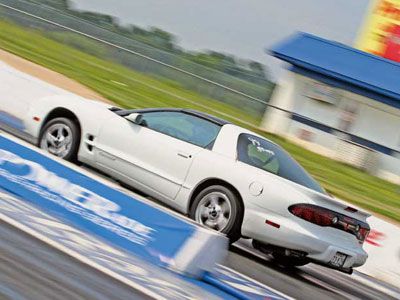
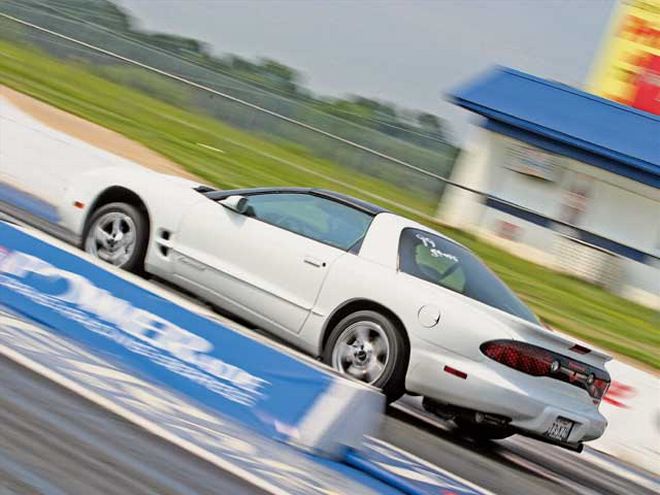
Having originated with the Chevy Monza and then migrating to the Chevy S-10, the 7.625-inch 10-bolt sitting under your Fourth-Generation Firebird certainly lacks a performance pedigree. Spend one minute on any of the late-model forums dedicated to GM Performance and when the conversation turns to rearends, a group roar erupts: "Junk the 10-bolt. Swap in a Ford 9-inch or GM 12-bolt."
But hold on a minute; does the name Jim Jones and Jonestown ring a bell? That's right, 913 innocent souls and Jim Jones drank spiked punch and perished in 1978 as part of the cult called the People's Temple. If one of those lost souls had an original thought, perhaps their fate would have been different.
Let's state categorically that the 10-bolt isn't junk, and if built correctly and used for everything but extreme drag racing, it's a very reliable rearend.
According to Jason Bailey, owner of Texas Drivetrain Performance in Fort Worth, Texas, "In the stock form, supplied with a Torsen limited-slip differential, and a 2.73 or 3.23 gear for the automatic or 3.42 for the manual, the 10-bolt rearend will usually support up to 350 rwhp. With elevated power levels, the weak points of the differential start to show up, resulting in parts breakage.
"The 10-bolts' weaknesses are the relatively light weight of the housing itself along with the 28-spline axles. Housing flex allows the ring gear to 'walk up' the pinion with elevated power levels, resulting in a broken gear set or damaged differential. The metal used in the axles can twist, especially at the axle ends, shearing them off.
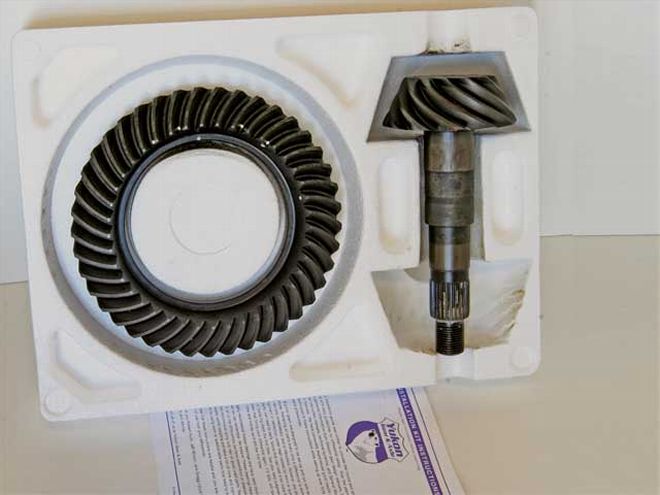 Here is the Yukon ring-and-pinion gear set from Randy's Ring & Pinion (PN GM 7.5-342) for $196.35. Yukon uses American Axle Manufacturing (AAM) gears as one of its gear suppliers. AAM is the OEM GM supplier of gears, and according to Jason Bailey, "They are the strongest and quietest gears on the market for the 7.5- and 7.625-inch 10-bolt."
Here is the Yukon ring-and-pinion gear set from Randy's Ring & Pinion (PN GM 7.5-342) for $196.35. Yukon uses American Axle Manufacturing (AAM) gears as one of its gear suppliers. AAM is the OEM GM supplier of gears, and according to Jason Bailey, "They are the strongest and quietest gears on the market for the 7.5- and 7.625-inch 10-bolt."
"By addressing the weak points and strengthening the rearend, a hobbyist can have a 10-bolt prepared that will live up to and beyond 425 rwhp. I have many customer's cars that have dipped into the high 10s or low 11s as well as competing on some of the most grueling road race courses across the country. For the quarter-mile racecar, there are better choices, especially for cars pushing over 450 rwhp or shocking the drivetrain with high-rpm manual-transmission launches."
For higher horsepower applications, there are several bolt-in aftermarket rearends, including GM 12-bolts and the Ford 9-inch. Before spending over $2,000 on an aftermarket rearend, determine how the Pontiac will be utilized and then make an informed spending decision.
Follow along as we go through a 7.625-inch 10-bolt teardown and buildup. Although we don't cover each and every step of the process, this story will provide comprehensive coverage of the major steps and parts in order to take your 10-bolt to the next level. This rearend is destined for none other than the STS rear-turbo-equipped '00 Formula WS6 covered in earlier issues.
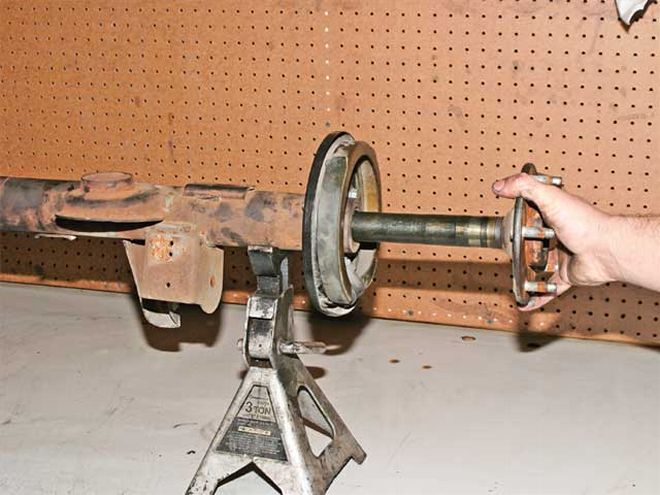 Then the axle was carefully pulled out of the end of the housing and stored. The process was repeated for the other axle.
Then the axle was carefully pulled out of the end of the housing and stored. The process was repeated for the other axle.
In stock form, the six-speed-equipped Formula sheared an axle on drag radials during drag testing. Now that the car pushes over 465 rwhp, only a maximum-effort 10-bolt can withstand the brutal power of the turbocharger. Since the rear-wheel horsepower rating of the Formula is pushing the outer limits of the 10-bolt, it should be noted that the primary use of the car is spirited street driving with very occasional trips to the dragstrip. If the car's use had been primarily at the track, an aftermarket rearend would have been highly recommended.
The teardown and subsequent build-up of a used housing was completed by Texas Drivetrain Performance of Fort Worth, Texas. Texas Drivetrain Performance has been in business for five years and is owned by Jason Bailey. This shop builds and repairs all makes of rearends and manual transmissions but specializes in late-model GM performance, including the 7.625-inch 10-bolt and the T-56 manual transmission. The shop is fully equipped with all of the specific GM Kent Moore service tools necessary to ensure that the rearend is built correctly. Peyton Performance Automotive of Waxahachie welded the axle tubes and straightened the housing, and Randy's Ring & Pinion of Everett, Washington, supplied the rearend components. Now let's get to work.
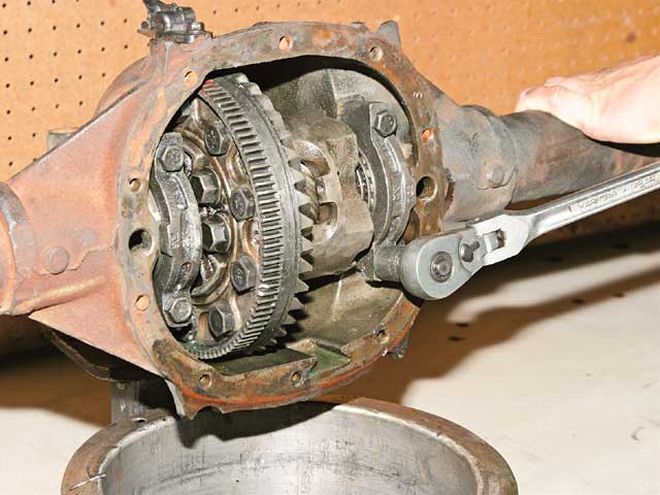 To remove the differential, a 5/8-inch socket and a 1/2-inch breaker bar was used to break each of the four bearing-cap bolts loose.
To remove the differential, a 5/8-inch socket and a 1/2-inch breaker bar was used to break each of the four bearing-cap bolts loose.
Conclusion
Check next month's issue as a replacement Eaton limited-slip differential and Yukon axles are installed along with a TA differential cover. We'll wrap up the 10-bolt build, presenting you with a breakdown of the parts list and cost of building the rearend, and then we'll perform a strength and cost comparison to the aforementioned GM 12-bolt and Ford 9-inch rearends.